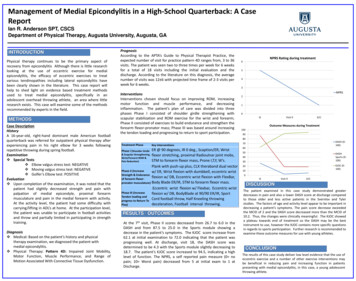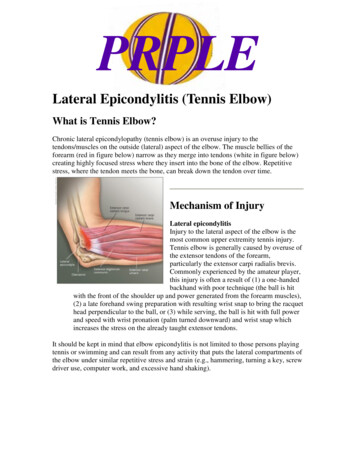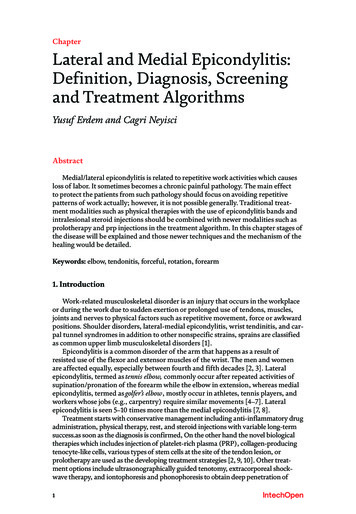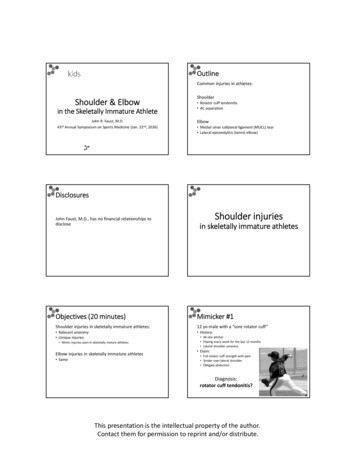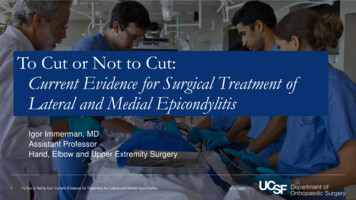Transcription
EPICONDYLITIS, MEDIAL(Golfer’s Elbow) DescriptionMedical epicondylitis is characterized by inflammation andpain on the inner side of the elbow where muscles and tendonsattach to the bone. The structures involved are the muscles andtendons of the forearm that bring your wrist down (flex thewrist). This occurs not only in golfers but in anyone who performs repeated resisted motions of the wrist. Without properintervention, this may develop into a chronic problem. Common Signs and Symptoms Pain and tenderness on the inner side of the elbow Pain or weakness with gripping activities Pain with twisting motions of the wrist, such as using ascrewdriver, playing golf, or bowling Causes Chronic, repetitive stress and strain to the muscles andtendons of the wrist and forearm to the elbow Sudden strain on the forearm, including wrist snap whenserving balls with racket sports or throwing a baseball Risk Increases With Sports or occupations that require repetitive and strenuousforearm and wrist movements (such as pitching a baseball,golfing, or carpentry) Poor physical conditioning (strength and flexibility) Inadequate warm-up before practice or play Resumption of activity before healing and rehabilitationand conditioning are complete Preventive Measures Appropriately warm up and stretch before practice orcompetition. Maintain appropriate conditioning: Wrist and forearm flexibility Muscle strength and endurance Cardiovascular fitness Ensure proper equipment fit. Use proper technique and have a coach correct impropertechnique. Wear an elbow (counterforce) brace. Expected Outcome Acute cases, in which symptoms are present less than 4weeks, are usually resolvable in 2 to 6 weeks. Chronic (repetitive) cases, in which symptoms have beenpresent for more than 8 weeks, may require 3 to 6 monthsto resolve and often require referral to a physical therapistor athletic trainer.238 Possible Complications Frequent recurrence of symptoms, resulting in a chronicproblem; appropriately addressing the problem the firsttime decreases frequency of recurrence Chronic inflammation, scarring, and partial tendon tearrequiring surgery Delayed healing or resolution of symptoms General Treatment ConsiderationsInitial treatment consists of medications and ice to relievepain, stretching and strengthening exercises, and modificationof the activity that initially caused the problem. These can allbe carried out at home for acute cases. Chronic cases oftenrequire referral to a physical therapist or athletic trainer forfurther evaluation and treatment. A counterforce (“tenniselbow”) brace may be recommended to reduce the forces tothe damaged tendon. If symptoms persist, an injection ofcortisone and anesthetics or surgical intervention may berequired. Surgery is occasionally necessary to excise the damaged tissue. This is done on an outpatient basis (you go homethe same day), with resumption of sports at 3 to 6 months. Medication Nonsteroidal anti-inflammatory medications, such as aspirinand ibuprofen (do not take within 7 days before surgery), orother minor pain relievers, such as acetaminophen, are oftenrecommended. Take these as directed by your physician.Contact your physician immediately if any bleeding, stomach upset, or signs of an allergic reaction occur. Cortisone injections reduce inflammation. However, this isdone only in extreme cases; there is a limit to the numberof times cortisone may be given due to the fact it weakensPronator teresFlexor ialisFlexor carpiulnarisFigure 1From Jobe FW: Operative Techniques in Upper Extremity SportsInjuries. St. Louis, Mosby Year Book, 1996, p. 441.
EPICONDYLITIS, MEDIAL239muscle and tendon tissue. Cortisone may also cause skinand subcutaneous fat atrophy (shrinkage and thinning) andskin depigmentation (lighter skin). Anesthetics temporarilyrelieve pain. Heat may be used before performing stretching andstrengthening activities prescribed by your physician,physical therapist, or athletic trainer. Use a heat pack or awarm soak. Heat and Cold Cold is used to relieve pain and reduce inflammation foracute and chronic cases. Cold should be applied for 10 to15 minutes every 2 to 3 hours for inflammation and painand immediately after any activity that aggravates yoursymptoms. Use ice packs or an ice massage. Use a towelbetween the ice and your elbow to reduce the chance ofinjury to the ulnar nerve at the inner elbow. Notify Our Office IfSymptoms get worse or do not improve in 2 weeks despitetreatment.
240 RANGE OF MOTION AND STRETCHINGEXERCISES Epicondylitis, Medial (Golfer’sElbow)These are some of the initial exercises you may startyour rehabilitation program with until you see yourphysician, physical therapist, or athletic trainer again oruntil your symptoms are resolved. Please remember: Flexible tissue is more tolerant of the stressesplaced on it during activities. Each stretch should be held for 20 to 30 seconds. A gentle stretching sensation should be felt.RANGE OF MOTION Wrist Flexion1. Hold yourwrist as shown with the fingers pointingdown toward the floor.2. Pull down on the wrist until you feel a stretch.3. Hold this position forseconds. Repeat exercisetimes,times per day.4. This exercise should be done with the elbow bent to 90degrees / straight. (Physician, physical therapist, or athletic trainer should circle one of these.)RANGE OF MOTION Wrist Extension1. Hold yourwrist as shown with the fingers pointingaway from the floor.2. Pull up on the wrist until you feel a stretch.3. Hold this position forseconds.4. Repeat exercisetimes,times per day.5. This exercise should be done with the elbow bent to 90degrees / straight. (Physician, physical therapist, or athletictrainer should circle one of these.)RANGE OF MOTION Wrist Extension1. Place the palm of yourhand flat on the top of atable as shown. Your fingers should be pointing backward.2. Press down, bending your wrist and straightening yourelbow until you feel a stretch.3. Hold this position forseconds.4. Repeat exercisetimes,times per day.
EPICONDYLITIS, MEDIAL241 STRENGTHENING EXERCISES Epicondylitis,Medial (Golfer’s Elbow)These are some of the initial exercises you may startyour rehabilitation program with until you see yourphysician, physical therapist, or athletic trainer again oruntil your symptoms are resolved. Please remember: Strong muscles with good endurance tolerate stressbetter. Do the exercises as initially prescribed by your physician, physical therapist, or athletic trainer. Progressslowly with each exercise, gradually increasing thenumber of repetitions and weight used under theirguidance.STRENGTH Wrist Extensors1. Sit or stand with your forearm supported as shown.2. Using apound weight or a piece of rubberband/tubing, bend your wrist slowly upward toward you.3. Hold this position forseconds and then slowly lowerthe wrist back to the starting position.4. Repeat exercisetimes,times per day.STRENGTH Wrist Flexors1. Sit or stand with your forearm supported as shown.2. Using apound weight or a piece of rubberband/tubing, bend your wrist slowly upward toward you.3. Hold this position forseconds and then slowly lowerthe wrist back to the starting position.4. Repeat exercisetimes,times per day.STRENGTH Wrist, Ulnar Deviation1. Stand with aoz. hammer in your hand as shown,or sit holding on to the rubber band/tubing with your armsupported as shown.2. Raise your hand upward behind you or pull down on therubber tubing.3. Hold this position forseconds and then slowly lowerthe wrist back to the starting position.4. Repeat exercisetimes,times per day.
242STRENGTH Grip1. Hold a wad of putty, soft modeling clay, a large sponge, asoft rubber ball, or a soft tennis ball in your hand as shown.2. Squeeze as hard as you can.3. Hold this position forseconds.4. Repeat exercisetimes,times per day.STRENGTH Supination1. Sit with your forearm supported on a table and the handover the edge and your palm facing the floor.2. Hold aoz. hammer or a stick with a weight on theend in your hand as shown.3. Turn your palm and hand toward you to a “thumbs-up”position.4. Hold this position forseconds and then slowly returnto the starting position.5. Repeat exercisetimes,times per day.STRENGTH Pronation1. Sit with your forearm supported on a table and the handover the edge and your palm facing up toward the ceiling.2. Hold aoz. hammer or a stick with a weight on theend in your hand as shown.3. Turn your palm and hand toward you to a “thumbs-up”position.4. Hold this position forseconds and then slowly returnto the starting position.5. Repeat exercisetimes,times per day.
Notes:Notes and suggestions(Up to 4400 characters only)
Initial treatment consists of medications and ice to relieve pain, stretching and strengthening exercises, and modification of the activity that initially caused the problem. These can all be carried out at home for acute cases. Chronic cases often require referral to a physical therapist or athletic trainer for further evaluation and treatment.
